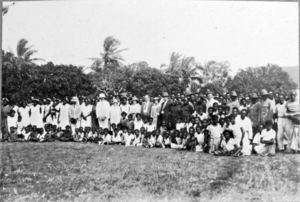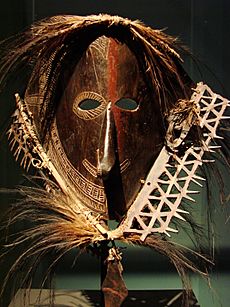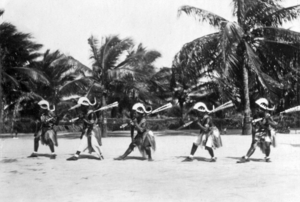Torres Strait Islanders facts for kids
 |
|
| Total population | |
|---|---|
| Total: 38,700 (TSI only), plus 32,200 (TSI and Aboriginal Australian); of these, 4,514 on the Islands | |
| Languages | |
| Torres Strait Island languages, Torres Strait Creole, Torres Strait English, Australian English | |
| Religion | |
| Christianity | |
| Related ethnic groups | |
| Melanesians | |
|
Note difficulties with census counts. |
The Torres Strait Islanders are the Indigenous people of the Torres Strait Islands. These islands are part of Queensland, Australia. They are different from the Aboriginal people who live on the Australian mainland. However, they are often grouped together as Indigenous Australians.
Today, many more Torres Strait Islander people live in mainland Australia (about 28,000) than on the islands (about 4,500). There are five main groups of Torres Strait Islander people. These groups are based on their location and culture. They speak two main Indigenous languages: Kalaw Lagaw Ya and Meriam Mir. Torres Strait Creole is also widely spoken, especially for trade. The Islanders have a strong connection to the sea and a rich artistic culture. This includes sculpture, printmaking, and mask-making.
Contents
Who are the Torres Strait Islanders?
The Torres Strait Islands are made up of 133 islands, but only 38 of them are lived on. The people and their culture are unique. They are different from their neighbours in Papua New Guinea and Indonesia. Over time, the islands have welcomed traders from Asia and other Pacific Islands. These traders came for things like sea cucumbers and shells.
In 2016, about 4,514 people lived on the islands. Most of them (91.8%) were Torres Strait Islander or Aboriginal Australian. Many Torres Strait Islander people also live in mainland Queensland. They live in places like Bamaga and Seisia on the northern tip of Cape York.
Distinct Cultural Groups
Torres Strait Islander people are mostly of Melanesian descent. This means they share some family and cultural links with people from New Guinea. They are distinct from Aboriginal Australians on the mainland.
The five-pointed star on the Torres Strait Islander Flag represents the five main cultural groups of the islands. Before European settlement, the islanders did not see themselves as one single group. They had strong connections with people in Papua New Guinea. This is because some islands are much closer to PNG than to Australia.
Experts generally agree there are five distinct groups. These groups are based on language and culture. Some examples of these groups include:
- The Eastern Islanders (like the Meriam people on Murray Island).
- The Top Western Islanders (like the Saibailgal on Boigu, Dauan, and Saibai).
- The Near Western Islanders (like the Maluilgal on Badu, Mabuiag, and Moa).
- The Central Islanders (on islands like Yam, Warraber, Coconut, and Masig).
- The Inner Islands (like Thursday Island and Horn Island).
Languages of the Islands
There are two main Indigenous languages spoken in the Torres Strait Islands. There is also a creole language.
- Kalaw Lagaw Ya is spoken on the southwestern, western, northern, and central islands. It is part of the Pama-Nyungan language family, which is found in Australia.
- Meriam Mir is spoken on the eastern islands. It is one of four Eastern Trans-Fly languages, with the other three spoken in Papua New Guinea.
- Torres Strait Creole is also widely spoken. It is a language based on English.
Island Culture and Traditions

The culture of the Torres Strait Islands has roots in Papuan and Austronesian traditions. For a long time, the people have been farmers and also hunters and gatherers. They traditionally hunted Dugongs, turtles, and fish. They also collected wild fruits and vegetables. These foods are still important for ceremonies and celebrations today. Hunting and fishing connect Islanders to their strong ties with the sea.
The Torres Strait Islanders have a unique culture. It shares some similarities with Australian Aboriginal and Papuan cultures. Historically, they have an oral tradition. This means stories are passed down through songs, dances, and ceremonies. As people of the sea, the ocean, sky, and land are very important in their stories and art.
Artistic Expressions
The ocean and nature deeply influence traditional art forms. You will often see turtles, fish, dugongs, sharks, seabirds, and saltwater crocodiles in their art. These animals are considered totemic beings, meaning they have special spiritual importance.
Torres Strait Islander people are the only culture in the world to make turtleshell masks. These are known as krar in the Western Islands and le-op in the Eastern Islands. Another important art form is wame (or wameya), which are many different string figures.
Elaborate headdresses called dhari (or dari) are made for ceremonial dances. The dhari is even featured on the Torres Strait Islander Flag. The islands also have a long history of woodcarving. They create masks and drums, often with beautiful decorations for ceremonies.
In the 1970s, young artists began to reconnect with traditional myths and legends. Books like Myths and Legends of the Torres Strait (1970) helped bring forgotten stories back to life. In the 1990s, artists like Dennis Nona began to create printmakings, linocuts, and etchings. They also made larger bronze sculptures. Other famous artists include Billy Missi and Alick Tipoti. These artists have added greatly to Australian Indigenous art. They bring amazing Melanesian carving skills and new stories.
Music and Dance

For Torres Strait Islander people, singing and dancing are like their "literature." They are a very important part of their way of life. Through songs and dances, they share their oral history. The dances show the stories, and the dancer is the storyteller. Many songs are about the weather, myths, legends, sea life, and important events. The movements in the dance express the songs.
Dance is also a way to be creative and compete. "Dance machines" (moving objects held in the hand), clappers, and headdresses make the performances even better. These dance items are linked to Islander traditions and family identity. Each island group has its own unique performances.
Artist Ken Thaiday Snr is famous for his detailed dari headdresses. These often have moving parts and feature the hammerhead shark, which is a powerful totem. Christine Anu is a well-known singer-songwriter of Torres Strait Islander heritage. She became popular with her song "My Island Home".
Beliefs and Spirituality
The Torres Strait Islander people still have their own traditional belief systems. The stories of the Tagai are a spiritual belief system. They show Torres Strait Islanders as people of the sea, connected to the stars. This system also explains how everything has its place in the world. The Islanders follow the instructions of the Tagai.
For example, one Tagai story tells of Tagai standing in a canoe. In his left hand, he holds a fishing spear, which represents the Southern Cross constellation. In his right hand, he holds a red fruit. In this story, Tagai and his 12 crew members ate all their food before a journey. So, Tagai tied them together in two groups of six and cast them into the sea. Their images became star patterns in the sky, which can be seen in the Pleiades and Orion constellations.
Some Torres Strait Islander people share beliefs similar to the Aboriginal peoples' Dreaming concepts. These are also passed down through oral history.
The Coming of the Light
From the 1870s, Christianity spread across the islands. It remains very strong among Torres Strait Islander people today. Christianity was first brought to the islands by missionaries from the London Missionary Society. They arrived on Erub (Darnley Island) on 1 July 1871.
A clan elder and warrior named Dabad met them. When a missionary presented a Bible to Dabad, he accepted it. This act was seen as the "Light" arriving, bringing Christianity to the Torres Strait Islands. The Islanders adopted Christian rituals and ceremonies. However, they also continued to keep their connection to the land, sea, and sky. They kept their traditional customs and cultural identity, known as Ailan Kastom.
The Islanders call this event "The Coming of the Light." All Island communities celebrate it every year on 1 July. The arrival of Christianity did not end their traditional beliefs. Instead, their culture shaped how they understood the new religion. The Christian God was welcomed, and the new religion became part of their daily lives.
Traditional Adoptions
A traditional cultural practice called kupai omasker allows a child to be adopted by a relative or community member. There are many reasons for this. For example, a family might need an heir to look after their land. Or it might be about caring for relationships between generations.
For a long time, these adoptions were not legally recognized in Queensland law. This meant adopted children could not take on the surname of their adoptive parents. In 2020, the Queensland Government passed a law to legally recognize this practice. The law is called the Meriba Omasker Kaziw Kazipa Act 2020, which means "For Our Children's Children."
Notable Torres Strait Islander People
Many Torres Strait Islander people have become well-known in different fields:
- Martin Nakata is the first person from the Torres Islands to earn a doctorate degree.
- Eddie Mabo was a land rights campaigner. He played a big role in a famous court case that changed Australian law on land ownership.
- Patty Mills is a famous NBA basketball player.
- Christine Anu is a popular singer and actress.
- Cynthia Lui was the first Torres Strait Islander elected to the Parliament of Queensland.
- Ken Thaiday Snr is a renowned artist.
- Sam Thaiday and Dane Gagai are well-known Australian National Rugby League players.
See also
 In Spanish: Isleños del estrecho de Torres para niños
In Spanish: Isleños del estrecho de Torres para niños


